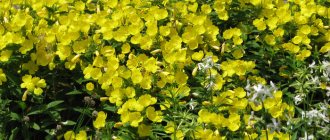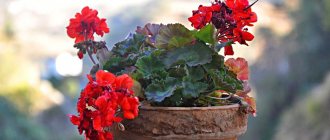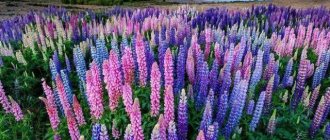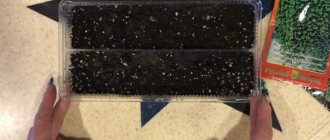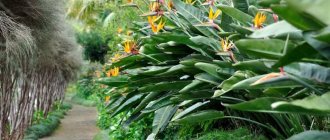Planting begonia seeds for seedlings and caring for them at home is a labor-intensive process that requires constant monitoring. However, by following all the rules of agricultural technology, you can get healthy and beautifully flowering plants for a long time.
Most often, decorative deciduous and ever-flowering begonia species are grown from seeds. However, tuberous varieties can also be obtained through seedlings, although this process is very long and labor-intensive.
Begonia seeds are recommended to be planted at the end of February or in the first ten days of March. At this time, daylight hours quickly increase and maintaining the required temperature becomes easier.
Description of the plant and popular varieties
Begonia is a low growing shrub or herbaceous plant with beautiful bright flowers. The leaves and stems differ in shape and color depending on the type of flower. The following types of begonia are most often grown at home:
Ampelous - it has cascading shoots up to 45 cm long. Flowers are formed after 5-6 leaf nodes in the leaf axils. Each flower lives up to 10 days, and after falling, a new one appears in its place. Thanks to this, the plant seems to bloom continuously until late autumn. The most popular variety of hanging begonia is considered to be Chanson; it has beautiful white or yellow lush flowers.
Tuberous - has a tuberous rhizome and a tall fleshy stem, which reaches a height of about 80 cm. There are varieties with simple and double flowers that resemble roses, camellias, carnations or peonies. Flowers can be small, up to 3 cm in diameter, or large, up to 20 cm in diameter. They can be located singly or in inflorescences. The most popular varieties of tuberous begonia are Duck Red, Picoti Harlequin, and Bouton de Rose.
Ever-blooming is a complex hybrid that combines all varietal qualities. It is a low-growing shrub with fleshy stems and smooth, heart-shaped leaves. Flowers can be painted white, pink and red, collected in various inflorescences. Among the ever-blooming begonias are terry varieties, the flowers of which have a huge number of petals. They resemble small roses. In total, there are about 600 varieties of ever-flowering begonia, among which the most commonly grown at home are Ray, Queen, and Cocktail.
Bolivianum is a tuberous plant with long drooping stems that grow up to 80 cm and hang down in several tiers. The flowers are formed in several pieces on short peduncles and have a bright orange color. This type of begonia is suitable for growing in pots and containers, as it grows well in a small amount of soil. The most common varieties of this species can be called Santa Cruz, Bonaparte, Belavista.
Application
Tuberous begonia is one of the most beautiful and long-blooming perennials. It decorates gardens, loggias and balconies, and home interiors. These plants, under the right conditions, bloom from May-June until late frosts. The choice of varieties is huge - they differ in color, appearance of flowers, shape and size of plants. This diversity allows you to create colorful single-species compositions from begonias.
Thanks to their rich range of colors, begonias in pots can be combined with other plants to create interesting compositions full of contrasts. Cascading begonias give a particularly impressive effect. Although they are very fancy and relatively difficult to grow, they look fantastic hanging down in long chains of flowers.
The most spectacular are terry and jagged varieties. Begonias are suitable for decorating balconies, terraces, entrance doors, paths leading to the house, and small garden architecture objects. Planted in the ground, they can create flower beds or borders (edging of flower beds), and decorate ponds.
Begonias are beautiful flowers, often grown in flower beds and in pots on balconies and terraces. They bloom until autumn; you can save begonia tubers in winter so that they bloom beautifully again a year later. These plants require a little patience and diligence, but grow well even for novice gardeners.
Seed selection
To grow beautiful and healthy plants, you need to choose high-quality seed material. When choosing them, you should consider the following:
- Packaging time. It is recommended to choose fresh seeds that were collected this year. The longer the seeds are, the less similar they will be, even if the expiration date indicated on the package has not yet expired.
- It is more convenient to plant granulated seeds in peat tablets. They have a dense coating of nutrients that make the seeds larger.
- It is more convenient to sow simple seeds in containers or seedling boxes.
Boarding time
Begonia seeds can be sown for seedlings from the end of January until April. Everyone determines the exact sowing time independently, depending on the characteristics of the plant development cycle. To ensure that begonia blooms as early as possible, planting is carried out in January. Then, by the time the seedlings are transplanted into the ground, they will have a well-developed root system and the seedlings will quickly take root in the new location.
Begonia will produce its first flowers 5 months after sowing the seeds, so it is worth sowing them as early as possible. However, this process should not be carried out before the end of January, since weather conditions do not correspond to the natural needs of the plant.
Do not forget about the specifics of different varieties of begonia. If you sow an ever-flowering begonia early, the seedlings will already be overgrown by the time they are transplanted into open ground. It will be difficult for it to take root in new conditions because of this the plant will lose its decorative properties. The plant will begin to bloom too early and the number of buds will be much smaller. It is recommended to plant the seeds of ever-flowering begonia in February.
Tuberous begonia, on the contrary, must be sown before mid-January. Then, by the time of transplantation, the leaves and buds of the flower will have time to form.
The main thing to remember is that by choosing the right time for sowing seeds for seedlings, you will ensure the normal development of tubers and the root system of plants.
Watch the video! Growing begonia from seeds
Vegetation and propagation of begonia
Planting tuberous begonia
When purchasing a begonia tuber, it is important to choose a healthy specimen with growth points beginning to “wake up.” It should be elastic and not wrinkled, without foreign stains.
If the purchased tuber does not have awakened growth points, then it needs to be “stimulated”. You can soak the onion for a day in Zircon solution or place it in a bag with a damp cloth or sawdust for several days.
The tuber is planted in the ground without being completely buried. Place the pot in a warm place and provide sufficient air humidity. Watering should be careful - along the edge of the container, without watering on the tuber.
Tuberous begonia blooming
Begonia usually blooms in summer and until mid-autumn. However, in favorable conditions when grown at home, it can delight the owner with its beauty from May to December.
Many flower owners cut off the buds of the plant by the end of autumn in order to prepare the tuber for winter rest, since the tuber needs a three-month rest period to maintain health.
Propagation of tuberous begonia by seeds
A common method of propagating tuberous begonia is by planting seeds.
To get a good result, you should carefully consider the purchase of seed material - the germination of seeds depends quite heavily on their freshness. It is best to plant seeds for seedlings from November to January.
You can plant seeds in universal soil, it is advisable to add coconut substrate there. The main condition is the lushness and airiness of the soil.
If there are none, you need to make drainage holes in the container. Remember that begonia does not tolerate flooding of soil!
The soil in the container is moistened with a spray bottle, avoiding waterlogging. Then the seeds are placed on the ground and very carefully sprayed again. A strong jet can wash away the seeds because they are very small. There is no need to sprinkle soil on top, and there is no need to press the seeds into the soil.
Then the container is covered with film or glass, creating a greenhouse. The greenhouse is ventilated every couple of days, if a lot of condensation forms, then more often. It is important to prevent the seeds and then the seedlings from rotting. The container is placed in a warm place and provided with lighting. For full growth of begonia shoots, about 12 hours of daylight are required.
As the substrate dries, the seedlings are very carefully watered - literally with drops of water from a syringe or from a spray bottle, but so that the seeds do not turn over and are washed off.
Seed germination is not immediately noticeable. During the first months, the plant grows a tuber, and only then produces the first leaves. At this time, you can start very diluted fertilizing and gradually increase the time of ventilation of the greenhouse.
You need to feed with very diluted fertilizer for decorative deciduous plants, carefully adding drops into the moist soil at the root of each sprout.
After the growth of two true leaves, the sprouts are planted in separate small-volume pots (50-100 ml cups), and after the seedlings have entwined the earthen ball with roots, they are planted in larger pots.
Flowering occurs already in the first year of the plant’s life.
Begonia propagation by tuber
Starting from the third year of life, begonia can be propagated by tubers. This division is also carried out to renew an old plant.
In the spring, the tuber is carefully divided into parts with a sharp knife (blade) so that each of the sections has a growth point with a sprout. The sections are treated with crushed coal and dried for about a day.
And then the pieces are planted in pots, gently pressing them into the ground. In this case, the tuber is not completely buried, leaving the top with the growing point open. After the sprout grows in height and reaches at least 5 cm, the corm can be sprinkled with earth.
Propagation of begonias by cuttings
In order to obtain new plants from begonia cuttings, it is necessary that the plant go through a three-month rest period (that is, it does not bloom or vegetate).
In this case, young sprouts are cut from the tuber (the sprouts should be about a month old, have two or three leaves and a couple of internodes). The cut area is sprinkled with charcoal and dried for 2-3 hours. Then the cuttings are planted in the ground.
The cut points of the cuttings on the tuber also need to be treated with charcoal to prevent the appearance of rot.
The seedlings are covered with a glass jar or “packed” in a bag to create greenhouse conditions. In this form, they wait for the cutting to begin to grow. If necessary, water the plantings (very carefully, without flooding). For germination, they provide long daylight hours and a comfortable temperature.
After it becomes obvious that the seedling is taking root, they begin to open the greenhouse, increasing the ventilation time and gradually accustoming the young plants to normal conditions.
Growing begonia with seeds
The technology of growing begonia from seeds differs from the well-known methods of growing seedlings for flowers, since the seeds of this plant are not like ordinary seeds from flower boxes. Begonia seeds are very small, more like dust than balls. Even poppy seeds seem large in comparison.
Preparing containers for seedlings
It is very important to choose the right container for seedlings so that they are strong and healthy. She must be:
- compact sizes;
- shallow.
The following containers are suitable for growing begonia seedlings:
- Containers for seedlings, which can be purchased at garden stores.
- Shallow wooden boxes.
- Peat tablets.
- Plastic cake molds.
In such a container it is convenient to care for seedlings and carry out picking.
Soil selection
It is from the soil that the plant receives all the necessary nutrients. The best results can be achieved using soil:
- slightly acidic;
- neutral.
This soil is sold in gardening stores, but you can prepare it yourself. To do this take:
- 2 parts of leaf soil obtained from rotting a large amount of foliage;
- 1 part peat;
- 1 part sand.
All components are thoroughly mixed and sifted through a sieve to remove excess lumps and impurities.
Seed preparation
Begonia seeds are so small that they are very difficult to work with. However, knowing some tricks, even a novice gardener can cope with this at home.
Due to its small size, the seed material cannot be soaked and disinfected. Therefore, it is necessary to disinfect the substrate.
Therefore, it is necessary to disinfect the substrate. Can:
- steam in a steam bath;
- calcine by placing the soil in the oven for half an hour at a temperature of 150 degrees;
- pickle by treating the mixture with a strong solution of manganese.
Important! No manufacturer can guarantee 100% seed germination. Pay attention to the harvesting date; hybrids are stored for no more than 1 year, varieties - up to 3 years).
It is better to buy seeds from a company that is already known to you or someone you know.
Sowing seeds
Begonia seeds are placed on the surface of the soil in pots; there is no need to cover them with soil on top.
To evenly distribute the seed over the surface of the ground, place a small even layer of snow on top and sprinkle the seeds on top. When the snow melts, the seeds will be distributed naturally on the ground.
If the snow was not used, after sowing the seeds, the soil must be moistened with warm water using a spray bottle. It is necessary to create a greenhouse effect in the container with sowing; to do this, cover it:
- glass;
- film;
- plastic cap;
- package;
- wet gauze, etc.
This cover is removed after the seedlings appear on the surface of the earth. In about 2-3 days. Before germination, crops must be kept in a room with an air temperature of 23-25°C.
Growing in peat tablets
If peat tablets are used for sowing seeds, then it is better to buy granulated seeds. This kind of sowing is much easier to carry out; moreover, there is no need to prepare containers and soil, and then pick up the seedlings.
Step-by-step technology:
- Peat tablets are placed in a tray and filled with water at room temperature so that they swell and increase in size.
- Granulated seeds are placed in the middle of the tablet without pressing the soil into the body. One tablet contains 1 granule.
- Moisten the seed from above with warm water from a spray bottle, since there will be little moisture in the peat tablet.
- To create a greenhouse effect, seed tablets are covered with a plastic container, bag or glass cup.
- Watering the plants must be done regularly through a tray so that the peat does not dry out. To do this, use a spray bottle so as not to pour too much.
- The tablets are kept in a room with an air temperature of no more than 20°C.
High-quality seeds should germinate 7-10 days after sowing, some varieties - after 2 weeks.
Next, it’s worth talking about why the seeds don’t germinate. Let us explain the most common reasons that affect the germination of seed.
Storing tubers in winter
In the first year of cultivation, begonias form conditioned tubers, suitable for plant propagation in the future. They develop especially well in the fall, when the plant does not waste energy maintaining the vegetative mass. At this time, a supply of nutrients accumulates and buds are formed for further renewal.
Bright blooming begonia
The tubers are resistant to the first cold, and therefore can be dug up after the leaves die. First, the stems of the begonia are cut off, leaving stumps 2-3 cm high. The dug up tubers need to be cleaned with a soft brush and washed with water.
Particular attention should be paid to the quality of drying, which lasts 10 days. If possible, first place the tubers in the sun, and after a few days continue drying in a well-ventilated area.
After this, the tubers are placed in one dense layer in a wooden box and covered with a mixture of peat and sand. The optimal temperature for storage is +10°C-+12°C, and air humidity is 50%.
If you decide to leave the begonia for the winter as a houseplant, you need to transplant it together with the earthen ball into a suitable pot. In winter, the plant must be provided with good lighting, but minimal watering.
What affects germination
Begonia does not germinate for the following reasons:
- Old seed – flower seeds can be stored for 1-3 years, so it is better to sow seeds collected last year.
- Substrate drying out - peat should always be moist; if it dries out, it will be difficult to wet it again.
- Temperature below +25° C - it is necessary to maintain the desired temperature in the room, if necessary, use additional heaters.
- Dry air – the air in the room should have normal humidity. If it is so dry and hot, it is recommended to spray the plant with water from a spray bottle or install automatic air humidifiers.
How to prepare begonia for winter
With the onset of autumn, tuberous begonia stops blooming and growing. Over time, the foliage begins to die and the shoots dry out. At this moment, the tuber begins to receive all the beneficial substances, which allows it to strengthen and grow.
As soon as cold weather sets in, dried shoots should be cut off and watering of the plant should be reduced.
If the flower grew in the garden, then with the onset of cold weather you should not immediately start digging up its tubers. Of course, as already mentioned, begonia loves warmth very much, but before digging up its bulbs you should wait until all the shoots and leaves die off and the beneficial substances pass quietly to the tubers. During this period, new growth points begin to form on them.
Young plants with small bulbs should overwinter in pots on well-lit windowsills. Under such conditions, the foliage and stems do not die off, but the growth and flowering of begonias stops. The air temperature in the room where the flower will winter should not be below +15 degrees. The plant is watered quite rarely.
Adult bulbs are stored in cool places. If the plant grew in a pot, then the bulb can be left to winter in it. If the tuber was dug out of the ground, then it should be placed in a box filled with sand or peat. Be sure to moisten the substrate in which the tubers are stored so that they do not dry out. The period in which the bulbs are dormant begins in November and lasts until February.
Seedling care
- For full development, begonias require regular watering, which is carried out with warm water in a tray or using a syringe under the root.
- Until the seeds have sprouted, the film or glass must be wiped daily to remove accumulated condensation. Plantings also need to be ventilated regularly.
- The seedlings should receive enough daylight, but they should not be exposed to direct sunlight so that the young seedlings do not get burned. Additionally, lighting is provided with fluorescent lamps. If the plants do not have enough lighting, they will begin to stretch out and lose their decorative appearance.
- At first, it may seem that the seedlings are practically not growing. There is no need to worry, since begonia first grows its root system and then begins to develop its above-ground part.
- 2 weeks after the emergence of seedlings, the seedlings need to be fed; for this purpose, fertilizer for deciduous and ornamental plants is used. The fertilizer solution is diluted 3-4 times the dosage recommended in the instructions.
- The soil around the grown seedlings must be loosened periodically.
- After 1-2 true leaves appear, the seedlings are planted.
Possible problems
Problems may arise with different methods of begonia propagation.:
- If the cut of the cutting begins to rot in the water, then it is quite possible that a fungal infection has occurred. After the rotted part has been removed, the shoot must be placed in fresh water, in which half a tablet of activated carbon should be dissolved.
- It happens that the shoots turn black. The cause is a fungal disease - gray rot, which appears when the plant is in a damp and cool room. It is necessary to treat with fungicides and create comfortable conditions in the room.
- Sometimes the seeds do not hatch for a long time. This occurs at low temperatures and dry soil.
- If the planted seedlings become thin and long, it means that they do not have enough sunlight.
- When the leaves of a plant curl and turn yellow, it is most likely that they do not have enough moisture or it is too hot in the room.
- If begonia grows slowly, it needs to be fertilized.
Picking seedlings
Picking begonia seedlings is carried out in 2 stages.
Stage 1
At the first stage, seedlings are placed with a gap of 6 cm between seedlings and between rows. A small amount of humus must be added to the soil, and after 2 weeks, complex fertilizer must be added, which can be bought at a garden store.
Stage 2
At the second stage, the seedlings are planted in separate cups or pots, the diameter of which should not exceed 8 cm. This procedure is carried out a month before transplanting the plants into open ground. The seedlings are kept in a room with a temperature of 18°C. When the weather conditions are good outside and the risk of frost returning has subsided, the seedlings are transferred to a permanent location.
Watch the video! Begonia pick
Requirements for planting site and soil
Begonias are very showy and grow quickly. Plants like moderate heat and do not like harsh sun. It is optimal to choose a slightly shaded position with a lot of diffused light - then the begonia blooms most profusely. In full shade it is less attractive. Staying in full sun is not advisable. It is better to choose secluded places, protected from strong winds.
Large-flowered and ampelous begonias tolerate the sun, but it is better to plant them in partial shade. Small-flowered does not tolerate direct sunlight at all. Leaves and flowers scorched by the bright midday sun instantly dry out and fall off. Neither variety will thrive in full sun, especially in hot, dry summers.
Begonias also do not like raindrops falling on them - they can rot and die. It is better to place flowers under a canopy. This will allow them to have beautifully colored leaves and flowers without a hint of fungal diseases and pests. Begonias have very fragile shoots, so the position must also be protected from winds that can break the delicate stems.
Begonia is a typical seasonal plant grown outdoors when there is no threat of frost. The optimal growth temperature is 20 degrees C, so the plant grows well indoors (it can be grown at home all year round).
Soil for begonias is preferable with the following characteristics:
- fertile,
- humus,
- permeable,
- with a neutral or slightly acidic reaction.
Universal soil for indoor plants should be loosened, for example, with river sand.
The tubers do not tolerate flooding, they rot easily, but they also do not like drought, so they should be watered systematically, but in moderation. They must have drainage at the bottom of the pot, and before planting in the ground it is also worth adding a drainage layer.
Diseases and pests
By following all the rules for growing begonia from seeds, you can significantly reduce the risk of seedling disease. However, you need to be aware of possible problems in order to see them in time and take the necessary measures. When growing begonia from seeds, the following diseases and pests may appear:
- Root rot, to get rid of this problem it is necessary to ventilate the greenhouse more often and reduce watering.
- Powdery mildew.
- Aphids and spider mites are controlled with insecticides and fungicides.

